Every mother understands that walking is useful for a baby at any age. But is there any benefit for newborn babies in the first month of their life? In autumn and winter, the weather is not always happy and it is interesting to find out how much you can walk with a newborn in November. Also, most parents wonder what should be purchased in advance and carried with them, how to dress the baby. It is useful to get information about the schedule and rules of walks at different times of the year, what weather you can walk in and what to do in case of illness.
Benefits of walking for a newborn
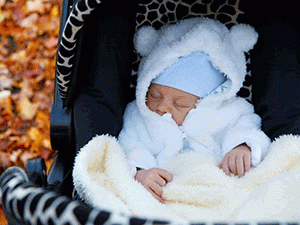 In the past, people spent a lot of time outdoors, so the need for walks remains today. Experts recommend that adults spend on the street 4-5 hours in a day. The same advice can be given to children of any age.
In the past, people spent a lot of time outdoors, so the need for walks remains today. Experts recommend that adults spend on the street 4-5 hours in a day. The same advice can be given to children of any age.
Newborns also need to walk more. Many doctors believe that excessively dry apartment air harms the mucous membranes of infants, which causes bronchitis, acute respiratory infections and other lung diseases.
Most of the children's problems are treated by walking and bathing, so the first and second do not happen much. , we already wrote in the previous section.
Of course, the first time after birth, the immunity of the little ones is still weak, and long walks will do more harm than good. On the question of how many days you can walk with a newborn, experts are not unanimous. Some recommend taking out for a walk only after a month, others argue that early walks safe if they are short-lived.
Pros of walking:
- increased appetite;
- sleep becomes stronger and healthier;
- immunity is strengthened;
- increases the ability to adapt;
- the baby is physically and mentally developing faster.
Walking instills immunity to walking. Therefore, late exposure to the street is much worse than too early.
You can increase the benefits of exercise with the help of nature. Walking with a newborn is better in parks, squares and near water bodies. There will be more benefits when walking near natural reservoirs (rivers, sea, lakes) and in the forest, and not near artificial ponds and in the park. Of course, you can’t walk with a toddler near parking lots and along highways.
When can I go for a walk in the first month?
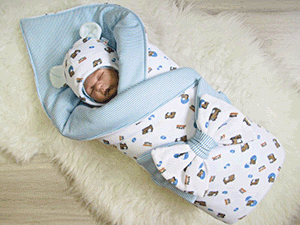 Immediately after discharge from the hospital with walks, it is better to wait. For the first time, it is advisable to go outside through 3-5 days. But some pediatricians say that you can wait 3-4 weeks after discharge, as the baby still has enough new space and germs in the apartment. In the summer, you can bring out the little one almost immediately, it is better to postpone the first walks with a newborn in winter for several weeks.
Immediately after discharge from the hospital with walks, it is better to wait. For the first time, it is advisable to go outside through 3-5 days. But some pediatricians say that you can wait 3-4 weeks after discharge, as the baby still has enough new space and germs in the apartment. In the summer, you can bring out the little one almost immediately, it is better to postpone the first walks with a newborn in winter for several weeks.
It is desirable that the first walk is no more than 10-15 minutes, it is better to walk with the baby without a stroller, carry him in your arms. Every day you should increase the walking time by 10 minutes, so bring the exercise time to 2 hours 2 times a day, in total - 4 hours. At temperatures below -15°C, it is better to cancel the first walk, in weather warmer than +15°C, the first walk can be increased immediately to 30-40 minutes.
A few rules for the first walks:
- You need to walk the baby after he has gone small and large, the diapers should be dry. This is especially important in winter and autumn.
- For the first time, it is preferable to walk with the baby in your arms. Mom's hugs will give him confidence and peace. Very useful.
- You can walk with the baby when he is full. After feeding, he will quickly fall asleep on the street.
- You can walk at a temperature not lower than -15 ° C and not higher than + 30 ° C, in calm, dry weather.
- Before 11 am and after 4 pm is the best time for a walk. At this time, the intensity of ultraviolet rays is still high, due to which vitamin D is produced. At the same time, the level of infrared rays decreases, which is why the baby does not overheat in the sun.
You can not walk with a toddler near parking lots and along highways.
Walking through the seasons: how long to start, what to wear
Let's find out how much you can walk with a newborn in autumn, summer and winter, what are the rules and recommendations, based on the time of year and weather.
In summer
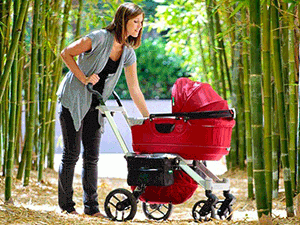 How much you can walk with a newborn in the summer, the pediatrician should decide, based on the level of health of the baby. You can not go outside immediately after discharge. It is necessary to wait at least 3-5 days, and preferably 7-10 days. The time of the first walk can be increased to 30-40 minutes.
How much you can walk with a newborn in the summer, the pediatrician should decide, based on the level of health of the baby. You can not go outside immediately after discharge. It is necessary to wait at least 3-5 days, and preferably 7-10 days. The time of the first walk can be increased to 30-40 minutes.
Remember that the ability of a child's body in thermoregulation is much lower than that of an adult. You need to increase the time gradually, adding 10 minutes daily. The baby can easily overheat or get heatstroke. Therefore, when walking in the summer, you need to monitor the condition of the child as carefully as in winter.
At summer walk you need to follow a few rules:
- Clothing should consist of natural cotton breathable fabrics. The same requirement applies to bonnets, a mattress and any other fabrics that a baby comes into contact with during a summer walk.
- You need to walk the baby before 11-12 o'clock in the afternoon and after 16-17 o'clock in the evening. Directly during the day, you should avoid being outside, as direct sunlight burns the baby's skin and can cause heat stroke.
- Due to the bright sun, you can walk with your child only in the shade of trees and buildings. When going out into the open, put the baby in the stroller and put on the sun visor.
- At artificial feeding Be sure to take a bottle of water with you.
- With artificial feeding, take all the nutrient mixtures for the baby in a dry form. Before feeding, dissolve them in water, which must be stored separately in a thermos.
- If you are a nursing mother, then take care of comfortable clothes. How to choose nursing underwear.
In summer optimal temperature for walking is 20-25°C. At a temperature of 15-20°C, the baby can wear warmer clothes, at 25-30°C, you can wear lighter clothes and walk in the shade. In summer, at temperatures below 15 ° C or above 30 ° C, refuse to walk.
The ability of a child's body in thermoregulation is much lower than that of an adult.
Autumn and spring
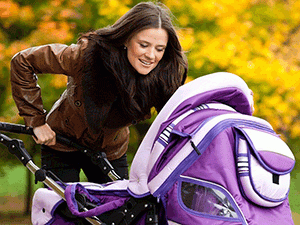 The basic rules remain the same: you need to wait 5-6 days after discharge from the hospital and the first walk must be short. The optimal time for the "first time" is 15-20 minutes. You also need to increase it by 10 minutes a day. Do not be tempted by the bright sun. In sunny weather, a strong cold wind often occurs, so you need to dress warmly.
The basic rules remain the same: you need to wait 5-6 days after discharge from the hospital and the first walk must be short. The optimal time for the "first time" is 15-20 minutes. You also need to increase it by 10 minutes a day. Do not be tempted by the bright sun. In sunny weather, a strong cold wind often occurs, so you need to dress warmly.
The first walk with a newborn in the fall has a couple of individual rules:
- The most comfortable type of clothing is overalls, it allows air to circulate throughout the body. Natural cotton items are worn under the overalls.
- Avoid walking in the rain. You can’t rely on a raincoat, since the main problem is not drops falling from above, but high humidity and low temperature. Humid air “takes away” heat much faster, as a result, the baby can catch a cold.
in winter
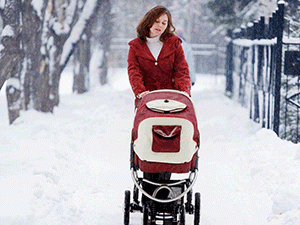 How much you can walk with a newborn in winter often depends on temperature and wind speed. You can ignore the snowfall, it does not affect the humidity of the air. The first walk in winter should be no more than 10 minutes, its time should be increased gradually, adding 10 minutes daily.
How much you can walk with a newborn in winter often depends on temperature and wind speed. You can ignore the snowfall, it does not affect the humidity of the air. The first walk in winter should be no more than 10 minutes, its time should be increased gradually, adding 10 minutes daily.
Winter conditions also create some special rules for walking:
- The ideal form of clothing is a transforming jumpsuit. It provides access to the back of the baby, as a result, swaddling is greatly simplified.
- It is better to move the time of the first walk to 2 weeks of age of the little one.
- The requirements for a dry bottom in winter are higher than ever. Due to wet diapers, heat transfer increases tenfold, as a result, a cold occurs instantly.
- In winter, a walk with a baby under 2 years old should be no more than an hour.
The minimum allowable temperature for winter walks is -10°C. At the same time, it should be taken into account that a strong wind increases heat transfer, as a result, the weather becomes subjectively colder. When the wind is above 7-10 meters per second, it is also better to wait for walks.
Preparing for a walk
When the first walk with a newborn in the fall, how to dress and what to take become the main issues. Before the walk, feed the baby, wait until he relieves himself, and then change the diaper. To prevent the child from sweating while waiting for you, first dress yourself, and then dress the baby. In cold weather, warm the stroller with a warm blanket.
In summer, the little one can be dressed in trousers, a T-shirt or a blouse (depending on the weather), be sure to wear a cap to protect from the sun. autumn the best option There will be overalls, a hat with ties and gloves. In winter, wear warmer clothes, a fur envelope or transforming overalls will do. Everything you need is in the previous article.
If you go out for 10-15 minutes, then you can take napkins with you and limit yourself to this. For long walks, be fully equipped, be sure to grab:
- wet wipes,
- feeding bottle,
- clean diapers.
Especially carefully you need to choose a stroller for a newborn:
- regardless of the functionality and equipment, the stroller must be strong, light enough, and the handle must fit your height or be adjustable;
- you should buy a cradle for a newborn, not a stroller, since the baby should lie, not sit in it;
- it is desirable that the stroller be compact, since you will have to take the elevator with it, store it somewhere;
- choose a stroller with large wheels on shock absorbers;
- the stroller should have an easily reclining visor;
- it is desirable that the stroller already has a branded mattress, ideally suited in size.
More about that, we wrote in a previous publication.
Summarize
You can take the child outside after at least 3-5 days, but it is better to wait a week. Walking a newborn in the first month is acceptable with good health of the little one. Make sure that the baby is dressed according to the weather, do not take him out during the rainy season or at extremely low or high temperatures.
Additional information about when and how much you can walk with the baby and what to wear on the video:
Take wet wipes with you, be sure to change diapers before walking so that the baby's skin is dry. Then walks will be really useful for the child.
The first walk with a newborn is an exciting event, even though young parents receive certificates and advice on raising and caring for the baby when they are discharged from the maternity hospital. If with breastfeeding And hygiene procedures everything is clear, then walks raise many questions and doubts. Especially young mothers do not know what to do in winter. Is it possible to walk in the cold season? When to take the baby outside? How to dress? How many minutes or hours should a walk with a newborn last?
However, winter is not the only time of the year to pay attention to. All 365 days a child can be exposed to such external irritants as exhaust gases, snow, rain, wind, sun, heat, dust, dirt, etc. Isn't it dangerous for a newly born baby and why go outside? Let's figure it out.
Benefits and travel times
Of course, various natural influences await the baby on the street, but this is even good. Immunity from the first days of life must adapt to environment so strengthening it with walks is the best solution. Everyone, without exception, knows about the benefits of fresh air and sunlight, and this applies not only to children, but also to adults.
At what age do you start walking? Many doctors recommend leaving the walls of the apartment almost immediately after discharge from the hospital. If the baby was born in the summer, then you should wait a week, and if in the winter - two weeks.
The total duration of the walk varies depending on the age of the crumbs, the approximate time is presented in the table below:
| Age | Spring | Summer | Autumn | Winter |
|---|---|---|---|---|
| First walk | 10–15 min. | 15–20 min. | 10–12 min. | 5–10 min. |
| Week 1 | 25–35 min. | 30–45 min. | 20–25 min. | 15–20 min. |
| 1 month | 2 times for 50-60 minutes. | 2 times for 1–1.5 hours | 2 times for 40-50 minutes. | 2 times for 30-40 minutes. |
| 3 months | 2 times for 1.5–2 hours | 2 times for 2.5–3 hours | 2 times for 1-2 hours | 2 times for 1 hour |
| 6 months | 2 times for 2 hours | 2 times for 2 hours or 1 time for 4-5 hours | 2 times for 1 hour | 2 times for 1 hour |
| 12 months | 1-2 times for 2-3 hours | 2-3 times for 2-3 hours | 2 times for 1–1.5 hours | 1-2 times for 1-1.5 hours |
We can talk endlessly about the usefulness of walking:
In addition, walking is also useful for mom: improving lactation, normalizing blood pressure. It is also a kind of physical exercise that perfectly helps to put the figure in order after childbirth, unwind and improve oxygen supply in the body. New acquaintances on playgrounds or in parks with the same mothers with strollers are another plus. Common topics for conversations will help to find good friends with whom it will be possible later to be friends with families.
It happens that the weather outside the window does not allow you to leave the house for a long time, for example, when the temperature is below -10 or above +30 degrees. Then the young parents decide to "walk" the child on the balcony. On the one hand, this is a good decision, because being within four walls for several days is not a good thing. On the other hand, many mothers begin to like this way of “walking”, the baby usually sleeps in the fresh air and does not interfere with anyone. However, he should not get used to sleeping in a stroller, otherwise there may be problems with putting him to bed in the future. The baby will be capricious and ask for air, you will have to open the windows and create a draft in the apartment.
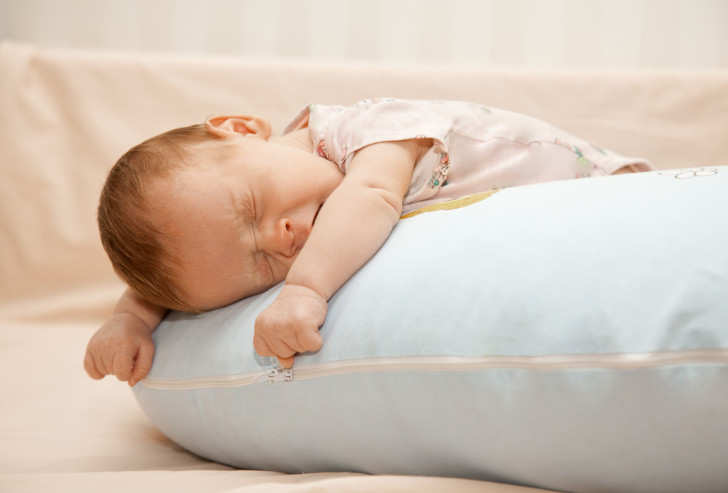 If mommy is tired or very busy, daytime sleep baby can be arranged on the balcony
If mommy is tired or very busy, daytime sleep baby can be arranged on the balcony If, nevertheless, the weather conditions are favorable and you went for a walk, you should follow a few rules:
- Do not walk on an empty stomach, especially since it will not be possible to attach a child to the breast on the street. Feed in advance. In addition, in the fresh air, a well-fed baby sleeps better and, accordingly, is less naughty. For yourself, you can take fruit or sandwiches, although it is also better to eat before a walk. Then there will be enough water or juice.
- Do not leave the stroller in the heat, but you should not stand idle for a long time in the shade. Warm weather with soft sunshine is the perfect time. Each season has its own rules.
- It is strictly forbidden to take a sick child (especially with a high temperature) outside. Heal first, otherwise aggravate the situation. The disease will take longer and more difficult. However, after treatment, it is imperative to restore walks, since clean fresh air contributes to recovery, especially in case of respiratory diseases: it helps to thin the mucus.
- Walk in parks, squares and coniferous forests. Avoid noisy places, as the baby may be frightened by loud noises. The quietest hours are in the morning from 9 to 12 and in the evening after 19:00. Accustom to street noise gradually.
Monitor your baby's well-being. It can freeze or, conversely, sweat, so dress for a walk always according to the weather.
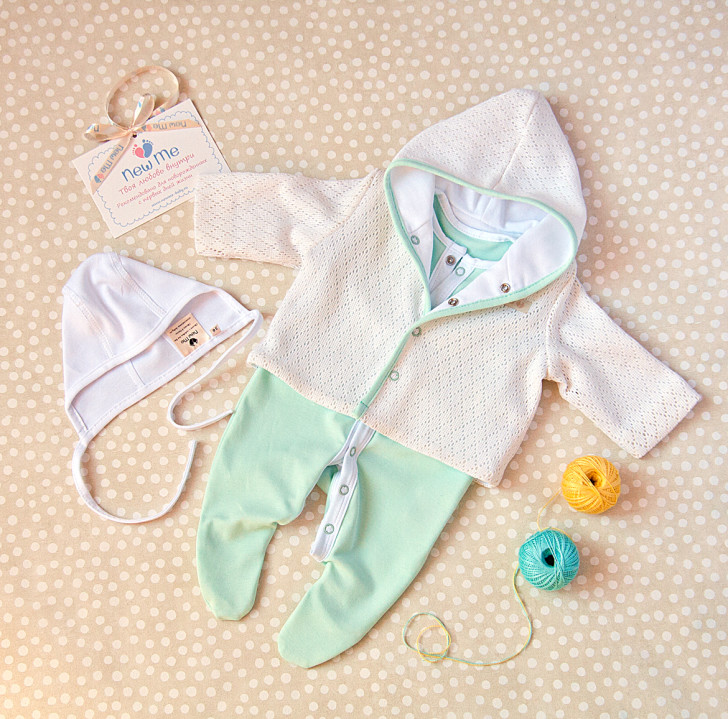 Do not overheat - the same important task as not to "freeze" the crumbs. Dress the child according to the weather, guided by the rule: clothes "as for yourself" + 1 layer
Do not overheat - the same important task as not to "freeze" the crumbs. Dress the child according to the weather, guided by the rule: clothes "as for yourself" + 1 layer How to dress and what to take?
Another important question tormenting mothers: Previously, layering was the norm, but now manufacturers offer wide choose children's clothing made from special materials suitable for certain weather conditions. These are jackets, and overalls, and hats. The main thing is that the child should be both warm and not too hot at the same time.
Be sure to bring a diaper, a pacifier, a handkerchief, a bottle of water, and a toy. If the baby wakes up and wants to be naughty, you can temporarily captivate him with his favorite toy, and in the frosty season close his mouth with a pacifier. This will prevent cold air from entering, which can cause a cold. During the warm season pure water will help quench your thirst. This is where a diaper is needed, because the baby still does not know how to control its natural processes, and no one likes to sleep in dirty and wet.
For yourself, you should take a book or magazine to sit on a bench in the park, because reading under open sky has always been considered the best pastime. You can carefully put all the necessary things in an envelope or a special bag on the stroller, if any. By the way, it is not necessary to walk with a stroller. If the physical condition of the mother allows, then you can walk around the yard with the baby in your arms for several minutes or just sit on a bench.
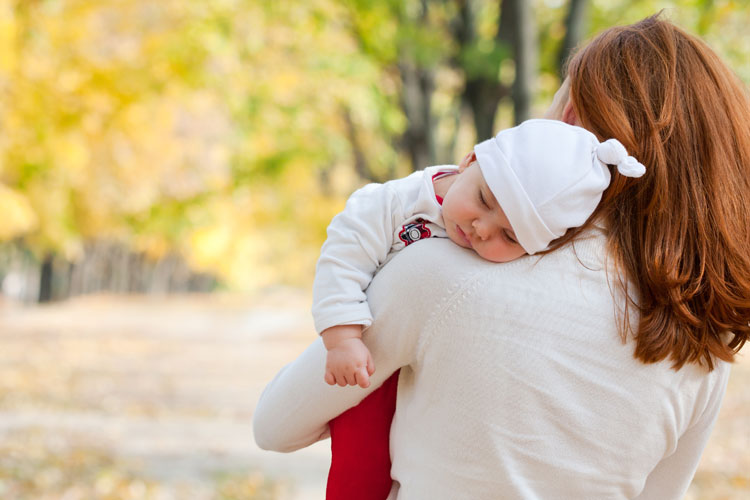 Physical contact between mother and baby is always welcome!
Physical contact between mother and baby is always welcome! Summer walks
If the baby was born in the summer, then after discharge from the hospital, it is worth adapting for 6-7 days before going out for a walk. Although some modern doctors claim that you can walk on the same day. For example, before getting into the car, walk around the maternity hospital for 10 minutes. The recommended air temperature is not higher than +30 degrees, and the humidity is not more than 80%. Of the basic rules, the following should be highlighted:
- Clothing should be comfortable, soft and made of pure cotton. Babies may be allergic to synthetic materials. In addition, synthetics prevent proper heat transfer and do not absorb sweat. It is better to buy a more expensive thing once than to suffer for a long time with skin irritation and constant crying because something itches.
- An ideal set of clothes - vests, sliders, a hat, shorts with a T-shirt or T-shirt, socks. Before buying things, pay attention to the quality of seams and applications. Incorrect and rough firmware can rub, interfere and cause discomfort to the baby.
- Summer reflective colors - white, pink and blue. In the heat, light shades will help to avoid sunstroke and overheating. The dark fabric quickly absorbs the sun's rays and creates a heavy atmosphere in the stroller. It is allowed to use baby creams with sun protection function.
- You need to start with 10 minutes of being outdoors and gradually increase to 2 hours. Ideally, walks should be organized every day in the morning and evening. Lunch is usually the hottest time of the day. At this point, it is better to arrange rest or feeding, i.e. sit at home.
In the summer the weather can be changeable, so be sure to bring a blanket or jacket in case it rains unexpectedly or strong winds rise. You can check the comfort of the baby by the neck: if it is hot - overheating, and if it is cold - hypothermia. The main thing is not to wrap too much so that the child can move or at least turn his head.
 Summer weather can be deceiving - always carry baby sunscreen and extra clothing
Summer weather can be deceiving - always carry baby sunscreen and extra clothing Autumn-spring walks
The most unpredictable weather occurs in autumn and spring. In foggy and windy weather, guessing with clothes can be very difficult. If the temperature is not lower than +10 degrees, then you can walk lightly, for example, in thin overalls and a hat. If the thermometer shows +5 and below, then we warm ourselves with a thick jacket or sling. By the way, a sling is a great solution for autumn. No need to take a mountain of warm clothes with you and worry that the baby will freeze. He can always be warmed by his maternal warmth.

A special children's raincoat is very convenient, which completely covers the stroller and saves the baby from a sudden onset of rain. Mom also needs to take care of her health and take an umbrella just in case. All this does not take up much space in the bag and allows you to get home dry. However, walking in the rain is not worth it. The raincoat creates a kind of greenhouse effect, and when you are in the stroller for a long time, it becomes stuffy and hot.
winter walks
If the baby was born in winter, then walks will have to wait. The first acquaintance with nature should take place no earlier than in two or three weeks, but how long can you walk with a newborn in this case? The duration of a walk with a newborn baby and its benefits are primarily affected by the temperature outside the window. If by the day of the first “outing” the temperature is about +5 ° C, then you can walk for 10 minutes, increasing the time by 5-7 minutes daily, gradually bringing the duration of the winter walk to 1 hour. When the winter air temperature drops to -15 ° C, in for the first time, it is better for a newborn to be on the street for 5 minutes, but no more than half an hour later. Red cheeks in a baby can be a sign that the baby is very hot. When there is a severe frost outside the window, below 15 ° C, it is better not to leave the house with a child and take breaks in the festivities. In such a situation, it is necessary to ventilate the room several times a day and wet cleaning.
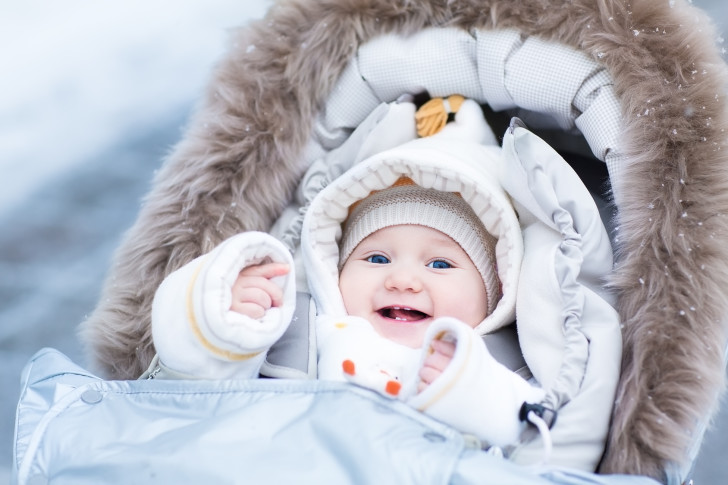 Winter walks with the baby are a necessary part of his development, since fresh air in the "diet" must be present every day, regardless of the weather. Correct selection children's little things will help to make a winter walk truly fun and enjoyable
Winter walks with the baby are a necessary part of his development, since fresh air in the "diet" must be present every day, regardless of the weather. Correct selection children's little things will help to make a winter walk truly fun and enjoyable It is advisable to walk twice a day, for example, before lunch and in the late afternoon. This applies to already adapted children. For beginners, in the first few weeks, being out of the house should not exceed 10 minutes. In winter, it is important to observe another rule: first the mother gets dressed, and then the baby. Sweating is a matter of minutes, but then it takes weeks to heal.
We will give a few more tips that will be useful to mothers of "winter" babies:
- Walking with a child in the cold will be pleasant if you pick up a good stroller. The issue of choosing a baby stroller should be approached responsibly and done even during pregnancy. When choosing a stroller, first of all, look at the wheels - they must be with shock absorbers, as well as on the inner surface of the cradle - it must be flat, with a flat bottom. Separately, it is worth buying a walking mattress in the stroller.
- A transforming jumpsuit with a detachable warm lining is very useful. Such overalls are warm and practical, they reliably protect all parts of the body from chapping and hypothermia. In addition, they are quickly and easily converted into an envelope. This useful feature makes it easy to undress the baby, even when he is sleeping. The jumpsuit can then be used in the autumn-spring period.
- 15-20 minutes before going out, spread the baby's face with a special baby cream that protects the skin from frost. Carefully read the annotation to what temperature this product is intended.
Do not use regular baby cream or zinc moisturizer as these do not protect your baby's delicate skin from exposure. low temperatures. Do not forget to also conduct an “anti-allergy” test: apply the cream on the child’s wrist in advance, evaluate the skin reaction after 20 minutes and after a day. If the skin "reacted" normally, then the cream is suitable.
- As for the baby's clothes, remember that they should not sit tight (this also applies to envelopes, and overalls, and even a warm swaddling blanket). It is important that there is an air gap between the layers of clothing, and that the baby can freely move his arms and legs - all this is a natural thermal insulation.
- The important point is that the child should not scream while walking, so as not to overcool the upper respiratory tract. You can solve this problem by taking a pacifier or a bottle of warm water with you. To keep warm will help: a self-heating bottle, a thermos or a cooler bag that maintains the temperature of the water.
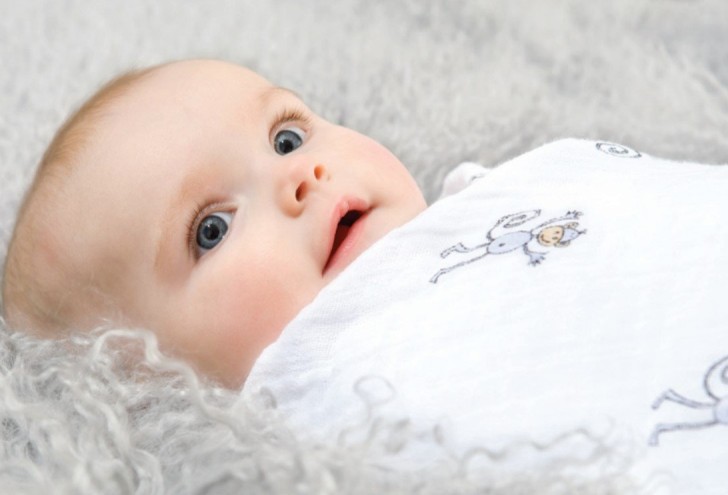 Swaddling in a blanket is a great way to keep your little one warm. In the process of wrapping, you need to make sure that the blanket does not pull the body, and the baby can freely move his legs
Swaddling in a blanket is a great way to keep your little one warm. In the process of wrapping, you need to make sure that the blanket does not pull the body, and the baby can freely move his legs Signs of overheating and frostbite
An older baby does not need so many clothes, as he moves a lot and is unlikely to freeze. Make sure that things do not hinder movement, as tight clothing interferes with normal blood circulation, the risk of frostbite increases, and there will be no benefit from walking. After you have dressed the baby and went out into the fresh air, do not forget to monitor his well-being, paying attention to whether he is sweating or cold.
The child is fine if:
- cheeks ruddy, but not red;
- nose and cheeks slightly warm;
- arms and back are cool, not cold;
- there are no complaints from the child himself and he does not cry.
Signs that your child is very cold may include:
- a red nose on a pale face with pale cheeks;
- cold hands and neck;
- cold legs - as a rule, hypothermia is felt first of all on the legs;
- if the child is crying.
Signs that a child is hot are:
- warm red cheeks at -10°C outdoor temperature;
- wet body;
- hot hands and sweaty feet.
 A warm jumpsuit combined with a hat is a great way to completely protect your child from frost even on the coldest day. Such a kit should not be used during warming, so that the baby does not sweat on a walk.
A warm jumpsuit combined with a hat is a great way to completely protect your child from frost even on the coldest day. Such a kit should not be used during warming, so that the baby does not sweat on a walk. When the baby is overcooled or he is very hot, he urgently needs to be taken home. First, evaluate the condition of the legs. If they are very cold, it is worth putting on another warm socks, if the legs are wet, change the socks to plain cotton ones. If the cheeks are red, smear them with cream.
Walk on the balcony
In bad weather, you can’t walk with a baby, but fresh air is needed every day. Dr. Komarovsky insists that in this case, the baby should be put to sleep on the balcony, and during this time the mother will have time to do household chores or also relax. However, not every balcony will be a useful alternative to the street. It is important to consider some features:
- The balcony must be glazed. Drafts, dust and unexpected loud noises can adversely affect your baby's health. In addition, a bird, insect or debris (cigarette butt, candy wrapper, seed husk) from the upper floors can fly in.
- The first and second floors are immediately excluded, since cars also drive in the yard and the child will not breathe fresh air, but exhaust gases. There are even cases when a soccer ball flies into the balcony from the street. A child can suffer not only from a blow, but also from broken glass. Ideal to live on 4-5 floors.
- You need to dress the same as for a street walk. The window on the balcony will be ajar, and the baby can easily catch a cold or overheat, depending on the weather.
Do not leave the newborn alone for a long time, or at least check his condition more often. A walk on the balcony can last up to 2 hours, but you should not abuse it in this way. In good weather, going out with a stroller to the park is the duty of every mother. Plus, it's good for her too. An exception may be the lack of an elevator, when a mother who has not recovered from a difficult birth is not able to drag the stroller up the stairs alone. In this case, no balcony will be very useful. E. O. Komarovsky in his book “The Beginning of Life”, emphasizes that in first 3-4 a month of walking on the balcony is the best option for both the baby and his mother.
How to swaddle a baby for a walk?
Quite tiny ones can be swaddled with a simple blanket, but not very tight! How to properly wrap a baby:
- Spread out Baby blanket on the changing surface with a rhombus. Top corner tuck under the blanket. They can cover the face of the baby on the street in severe frost.
- Having laid the child diagonally, we begin to wrap it, covering it first, for example, with the right corner of the blanket. The corner should be tucked under the back only if the blanket is not very thick.
- Part of the blanket, with which swaddling began, completely cover the body, close the handle.
- The next step is to cover the legs. We cover the child from the legs to the neck with the lower corner of the blanket, and fold the edge inward.
- At the end, we throw the free, left edge of the blanket over the bundle and fix it.
Conclusion
Young parents need to know not only how much to walk with a newborn on the street, but also how to plan their day (we recommend reading:). After the birth of a child, a girl’s life changes dramatically and you need to adapt everywhere in time. It is worth building a certain daily routine in order to learn how to cope with both the upbringing of the crumbs and all household chores at the same time. The main thing to remember is that fresh air and sunlight are sources of vitality and joyful mood. With the right approach, your baby will grow up healthy, calm and smart. In extreme cases, grandparents are always happy to help and take a walk with their grandson or granddaughter.
As a rule, both kids and their parents like being outdoors. But in reality, families have difficulty scheduling walks. Dad spends all day at work, and mom is loaded with household chores. As a result, it is not possible to spend a lot of time on the street, which worries adults. Therefore, it is important to figure out how much you need to walk with a newborn and how to properly organize this process.
A baby needs fresh air as much as mother's milk and daily hygiene. Walking strengthens and hardens the body. On the street, cells are enriched with oxygen, and the lungs undergo natural cleaning. In addition, being on the street, your baby gets acquainted with outside world, the dynamism of which stimulates the development of mental abilities and the nervous system.
Newly-made parents are told about the importance of walking even in the maternity hospital. But once at home, adults very quickly realize that it is not so easy to go out with a toddler. There is a problem of lack of time, and a lot of fears, how to protect the child from possible natural hazards.

Like clockwork
As for the first point, the situation is as follows. The more healthy child in good weather will happen on the street, the better. But if you do not have a nanny or grandmother who could constantly walk with the baby while you are busy with household chores, you need to decide on the necessary minimum time.
age scheme
For newly born children, walking time is limited at first. 5-10 days after discharge, the baby is first taken out into the yard for 10-20 minutes, depending on the weather and season. Further, the walking time increases daily by 10-15 minutes. At 1 month, the baby can already be outside for more than an hour in winter and about 2.5 hours in summer.
Table - the average scheme of walks at different times of the year
| Age | Winter | Spring | Summer | Autumn |
|---|---|---|---|---|
| 5-10 days | 5-10 minutes | 10-15 minutes | 15-20 minutes | 10-15 minutes |
| 1 month | 60-80 minutes | 1.5-2 hours | 2.5-3 hours | 1,5 hour |
| 3 months | 1,5 hour | 3-4 hours | 4-5 hours | 2-3 hours |
| 6 months | 2 hours | 4 hours | 5-6 hours | 3-4 hours |
| 12 months | 2 hours | 4-5 hours | 5-6 hours | 3-4 hours |
As you get older, the minimum required time for walking increases. The right thing to do would be to break it into pieces. For example, in the summer, a three-month-old baby can walk 2 hours before lunch and 2 hours after 4:00 pm. And he can take oxygen baths for another hour while sleeping on the balcony, unless, of course, the site faces the sunny side.
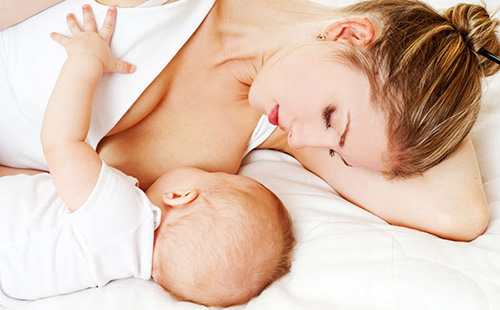
Feeding: before or after
If we talk about whether you need to walk before or after eating, then it is worth remembering that fresh air improves appetite. Therefore, if you go outside with a hungry baby, your walk will last no more than half an hour. Although, in summer it is not so important for breastfed children to go out into the yard before or after feeding. Having picked up the appropriate clothes, you can breastfeed your baby at any time. In winter, of course, this option will not work.
But with children on artificial feeding, everything is more difficult. You can not take the finished mixture with you. The only way out is to fill the feeding container with dry mix and take a thermos with warm water. But in the frosty season, you can’t do this, otherwise the child will pick up cold air.
Indeed, it takes a lot of time to walk, so parents will have to learn how to combine business with pleasure. For example, with a child, you can go to a store or to a bank to pay utility bills. There is a plus here - with children they skip the line.
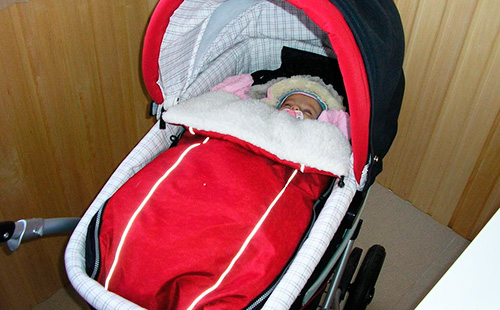
Lifesaver balcony
About balcony walks need to be said separately. Many criticize this type of "oxygen therapy", but it happens that parents simply do not have the opportunity to otherwise organize a trip to the street. In any case, this part of the apartment should be adapted for the baby. The closed frame and high windows will protect kids from falling from a height, and mosquito nets will protect them from insects.
Seasonal nuances
The seasonal factor not only affects the time of walking, but also dictates the rules for how to collect the baby on the street. Here are the main seasonal features to consider.
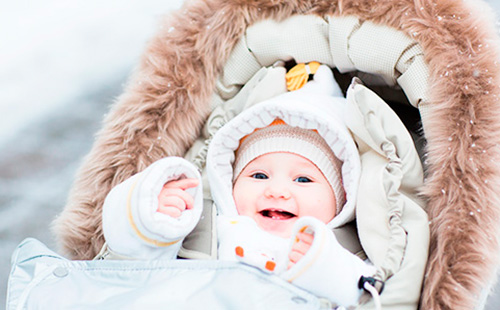
Winter
Features: it is not recommended to take the baby outside if the temperature drops below −10-15°C. Winter walks are especially useful, because at this time of the year the air is additionally saturated with oxygen. Remember that heat transfer in the baby's body is much more intense than in adults. As a result, the temperature is felt differently. For example, if the mother is warm, then the baby is hot. If she is a little cool, then the baby is normal. Therefore, do not overdo it with clothes, it is better to take an extra blanket with you.
Air temperature: down to -10°C.
Required clothing:
- diaper;
- knitted slip;
- socks, booties;
- knitted cap and hat with earflaps on sheepskin;
- scarf;
- envelope or closed overalls on sheepskin.
What should be the stroller:
- with powerful rubber wheels, with high shock absorption and cross-country ability;
- with additional warming elements, including removable ones.
Risks:
- frostbite;
- overheating.
What to take with you:
- spare blanket;
- raincoat in case of wet snow;
- handkerchief;
- pacifier.
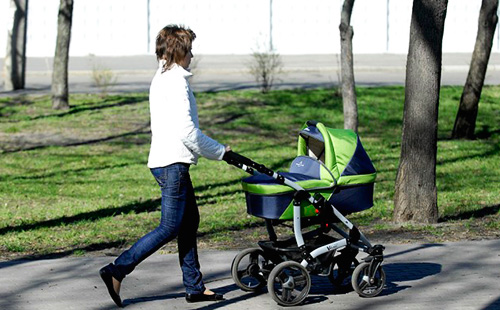
Spring
Features: at the beginning of spring, the weather is changeable, so it is easy to make a mistake with the selection of a wardrobe for the crumbs. At this time of the year, you can take the child outside not only in a stroller, but also in a sling or a special carrier.
Air temperature:+15-+17°C.
Required clothing:
- diaper;
- cotton slip;
- socks;
- demi-season hat;
- padded velor coverall.
What should be the stroller:
- with large basket.
Risks:
- overheating;
- insect bites;
- allergy to pollen from flowering plants.
What to take with you:
- spare blanket;
- raincoat and mosquito cape;
- wet wipes;
- handkerchief;
- pacifier.
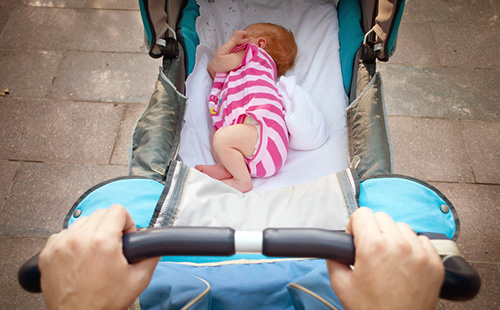
Summer
Features: a good period to saturate the body with vitamin D. But excessive sun exposure is dangerous, so walking at temperatures above +30°C is not recommended. The clothes of the baby should be exclusively light colors. Headwear is a must.
Air temperature:+25-+30°C.
Required clothing:
- diaper;
- cotton slip, bodysuit or suit with short sleeves;
- socks;
- Panama.
What should be the stroller:
- equipped with a deep hood that will allow you to hide the baby in the burning sun;
- equipped with a raincoat and a mosquito cape;
- with large basket.
Risks:
- overheating;
- sunburn;
- insect bites.
What to take with you:
- mosquito cape;
- a bottle of boiled water;
- wet wipes;
- handkerchief;
- spare diaper;
- pacifier.
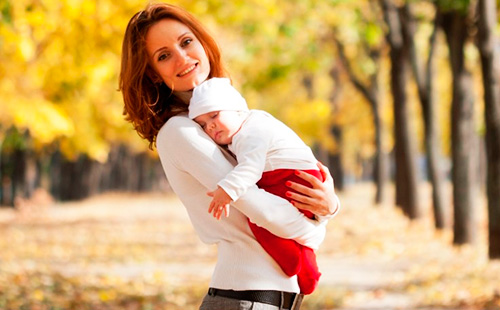
Autumn
Features: autumn is characterized by frequent pressure drops. Temperature and humidity often change, it rains. All this can affect the behavior and well-being of the crumbs. In order to calmly walk during this period, it is worth having additional means of insulation and protection against moisture.
Air temperature:+2-+8°C.
Required clothing:
- diaper;
- cotton slip;
- fleece slip or closed fleece overalls;
- socks;
- knitted cap and demi-season insulated hat;
- insulated demi-season envelope or overalls.
What should be the stroller:
- capacious to additionally wrap the baby without any problems;
- made of moisture and wind resistant materials;
- with additional warming elements, including removable ones;
- equipped with a raincoat;
- with large basket.
Risks:
- overheating;
- hypothermia;
- difficulty breathing due to burning leaves.
What to take with you:
- spare blanket;
- raincoat;
- umbrella;
- handkerchief;
- pacifier.
The given scheme of walks, the list of obligatory clothes and seasonal accessories are not static. Adjustments can be made by bad weather or Bad mood baby. You can follow these guidelines, and when you “fill your hand”, you yourself will adjust the frequency of being on the street, weed out or add additional walking attributes.
If now you are frightened by the amount of accumulated household chores and are afraid that you won’t even pull the walking “norm”, calm down. Many mothers go through this. You, like a baby, just need to adapt. Very soon you will learn how to build the right daily routine, when walking with a newborn is not a duty, but a pleasure.
196
6 April 2017
When can I walk with a newborn after the hospital. How many walks with a child in winter, spring, autumn and summer. Where to walk is not worth it and what is the alternative to walking.
The first meeting with the baby and moving home from the hospital behind. The baby sleeps peacefully in his bed. Very soon the doctor will come to examine the crumbs, and it will be possible to go for the first walk. Is it possible?
When to go for a walk after the hospital
There is no single answer to this question, because everything will depend on the climatic conditions of the region, the weather outside, the time of year, and the well-being of mommy. In addition to objective reasons, some parents try to adhere to the ancient principles and not take the child out into the street in the first 40-66 days from the moment of birth.
Experts do not set strict limits in this matter. Under good weather conditions (not too hot, not too cold, no snow, rain, strong wind) for the first walk with a newborn baby you can go out already 3-5 days after discharge .
Fresh air hardens the body of the crumbs, helps it adapt to new conditions. Walking can calm even the most anxious baby, improve his appetite.
Of course, the figures above are approximate. Each mother can decide for herself when it is worth "bringing out" her child. It is worth taking into account not only the benefits for the child, but also the physical condition of the mother. After childbirth, every woman needs a good rest, not everyone has the strength to lift a heavy stroller. In such a situation, it is better to postpone walks until the restoration of health or the appearance of an assistant.
When and where not to walk
Weather conditions often become an obstacle to walking with a newborn child. Every mother, before leaving the house, wonders about the temperature, the wind. You can rely on a few simple rules in this matter:
- in winter time the child may become overcooled, since the thermoregulation system is still imperfect, therefore it is better not to walk with the newborn at temperatures below -15;
- In summer, the situation is reversed: the baby can get a heat stroke. Walks at +30 and above are not recommended.
Park areas and squares are better suited for walking with a child. You should not walk along busy highways, the child should not breathe exhaust fumes.
An alternative to walking
Walking is very useful for a newborn child, but it happens that weather conditions or the mother’s well-being interfere with a normal walk. Then you can use the "fallback" - a balcony or loggia. The kid will get his portion of fresh air, and at this time the mother will be able to do household chores or relax. Before taking the baby in the stroller to the balcony, the mother must make sure that the baby is safe:
- on the balcony and on the roof of the house there should be no foreign things that can get into the stroller to the child;
- the balcony should not overlook the polluted road.
An ideal place for a child to sleep would be the balcony of a country house located in a green area. In city apartments, the balcony should face the courtyard so that the baby does not breathe exhaust fumes.
How much to walk
There are no clear guidelines on this issue either. You need to look at the well-being of mom and baby. At the first acquaintance of the baby with the street, young parents can do without a stroller. The child can be carried in your arms for 10-15 minutes. Each time the duration of the walk should be increased by 5-10 minutes. The optimal time for a walk for a child in good weather is 2 hours. After the child reaches the age of one month, you need to walk 2 times a day for 2 hours.
For convenience, it is better to present the data in the form of a table.
Walks through the seasons
The change of seasons and weather conditions "dictates" its own rules for walking. There are several recommendations to keep in mind.
Summer walks
There is an opinion that in the hot season a child can be outside for an unlimited amount of time. This is not entirely true. The systems of a newborn baby are still imperfect, the baby can get heat stroke from prolonged exposure to the sun. To avoid the unpleasant consequences of walking, you need to follow simple rules:
- choose natural clothes for the child that will allow the skin to breathe;
- linen in the crib of a newborn should also be natural;
- don't be in the hot sun. At a temperature of +30 degrees and above, the walk should be moved to an early (before 11 o'clock in the afternoon) or evening (when the heat subsides) time;
- the baby's head must be protected with a Panama hat or a light cap.
If the weather is favorable in summer, you can walk with your child several times a day. You can take a bottle of water with you for a walk, a pacifier to calm the baby if he wakes up. 
How to walk in spring and autumn
Changeable weather during these seasons is not uncommon. The bright sun can suddenly turn into rain. In order not to catch a cold during such walks, you need to follow a few rules:
- try to avoid walking in rainy weather. Modern strollers have raincoats (capes that protect the baby and the stroller from getting wet), but this accessory should be used only as a last resort, since a greenhouse effect is created inside the stroller, the baby does not have enough fresh air;
- do not rush to undress the child, even if the sun has come out. The weather is very changeable, there is a high risk of catching a cold. For walks in the off-season, it is best to use demi-season clothing that does not overheat the skin, allowing it to breathe and protects the child from hypothermia.
In dry, warm weather, the baby's first walk can last 15 minutes. gradually increase the time to 1.5 hours.
winter walks
Walking in winter raises many questions for parents. It’s cold outside, which means you should think about how to dress your child so that he doesn’t overheat or freeze. Some parents even refuse winter walks, believing that cold air will only hurt. Of course, this opinion is wrong. Walking in winter is possible and necessary. 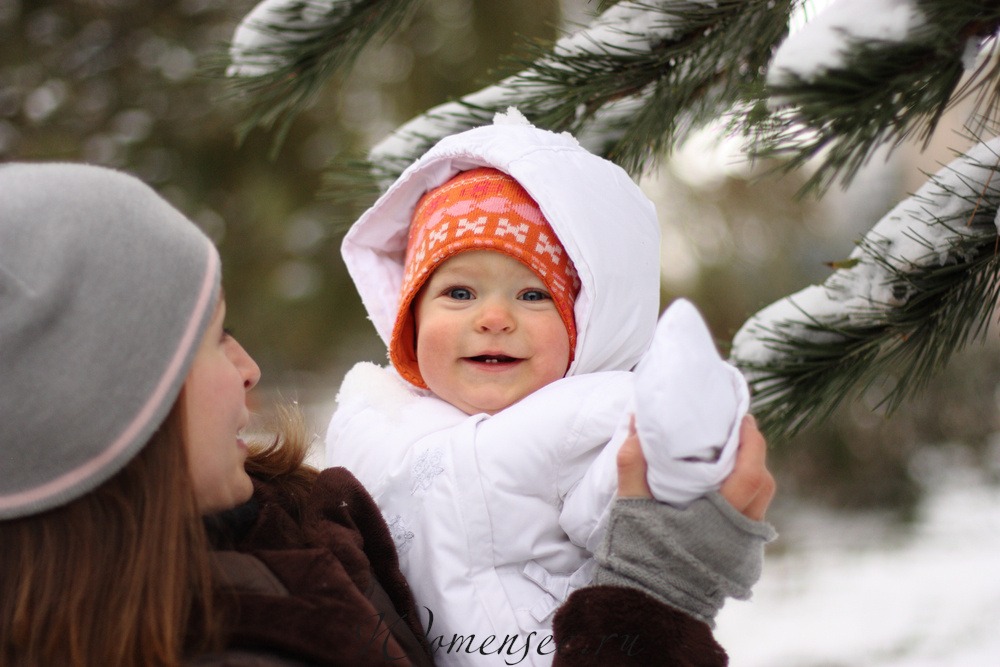
Here are a few winter walk rules that will help moms and dads:
- the first walk should take place no earlier than 14 days from the date of birth;
- at comfortable temperature air (up to -5) you can walk for 15 minutes, if the temperature drops to -15, the walk time is reduced by 5 minutes. At lower rates, walking with a newborn is not worth it;
- with a strong wind, walking with a newborn can be replaced by sleeping on the balcony;
- the maximum duration of a walk in winter is 1.5 hours;
Take care of warm and comfortable clothes for the crumbs. many parents note the advantages of transforming overalls, they retain heat well and are easily removed, so at home it will be possible to undress the baby without disturbing his sleep.
Walking with children older than one year
Children aged 1 year and older should go out at any time of the year. There are few adverse weather conditions under which the walk may not take place: salt rain, thunderstorm, heat (more than 30 degrees), frost (more than -20 degrees).
Temporary reference points of 1.5-2 hours are rather conditional. The "borders" of the walk are set by the child himself (most often the walk ends when the baby wants to eat or sleep).
Particular attention should be paid to winter walks, because many parents do not take their kids outside in winter, fearing they will catch a cold. A child may catch a cold if:
- not dressed for the weather
- his body is not tempered.
Don't put too many clothes on your child. Children are very mobile, so they can quickly sweat and catch a cold. Experienced parents recommend checking the child's body temperature on the skin on the hands (just above the hands), the bridge of the nose, and the neck (if they are warm, the child is comfortable, if they are cold, the baby is cold).
Walks are necessary for every child, they harden the body, help the baby calm down, but not just being on the street can bring benefits. So, walking in severe frost, heat is more likely to harm the body of the crumbs. Walks near highways will not bring any benefit, it is worth avoiding places of large crowds of people (especially during epidemics). Walk wisely, then walking will be beneficial.
From the maternity hospital, the baby is brought home, and when it is possible to walk with the newborn in the summer, the mother and father may not know. It is necessary to take into account the season, the length of the walk, the weather and choose clothes.
When can you start walking with a newborn in the summer?
The first walk with a newborn in summer is allowed a week after birth, with good health of the baby. The doctor will inform you about this at the time of discharge.
During the first walks, the baby is dozing. The uniform rocking of the stroller puts you to sleep. After a short period of time, the child will sleep less and be interested in the world around him. At the age of two months, colorful toys cling to the stroller.
When walking with a newborn, you need to follow the general recommendations:
- Take into account the health of the baby. With anxiety or whims, it is necessary to postpone the trip to the street.
- It is advisable to plan walks with a newborn after meals. The child will be happy and serene, and the nap will be strong.
- Pay attention to the weather conditions - find out the air temperature in advance. If +30 C and yours, it is forbidden to walk.
- Take a walk at a suitable time for the mother - in the morning (10.00 - 12.00) and in the afternoon (14.00 - 16.00).
- Choose your stroller wisely. Walking in a stroller is not allowed. An impeccable option will be special equipment for walking with newborns or transforming strollers with cradles. You need to put a mattress in the stroller.
- When walking with a newborn, it is not appropriate to walk near the roadway. A park area or squares, that is, quiet places, is well suited. Crowded places are a source of awakening, and noise frightens the child. The ideal option is a coniferous forest with clean air.
- Take a spare pacifier on the road.
- Until the age of two weeks, walk once. Then increase the amount.
- Cancel a walk with a newborn if the moisture content of the atmosphere exceeds 80%.
- Children benefit from vitamin D, which can be obtained under the sun. Therefore, it is recommended to substitute the face, arms and legs under the rays. To avoid heat stroke, you should not abuse sunbathing.
- In bright sunshine, the stroller should be under the shade.
Walking with a newborn in the summer in the heat Komarovsky video:
How to dress a newborn for a walk in the summer?
What to walk with a newborn in the summer? It is believed that walking with a newborn in the summer does not cause misunderstandings. However, this opinion is erroneous: the baby can overheat due to the heat, and heavy rain or wind can provoke illness and hypothermia.
- Any outfit must be sewn from natural cotton linen. Such products breathe, observe the required heat exchange and do not provoke allergies.
- Colors - bed tones (white, pink, blue or cream).
- Rough seams and applications rub the baby's skin and cause inconvenience.
- Dress the baby in a vest with sliders or in a thin jumpsuit (long sleeve). Bodysuits and dresses (short sleeves) are also suitable.
- An integral attribute of clothing - a hat white color to reflect the rays of the sun.
- You need to take spare diapers, a jacket (long sleeves) and a warm blanket. All this will come in handy in case of a sharp change in weather.
- A couple of diapers and wet wipes.
How long can you walk with a newborn in the summer?
How much to walk with a newborn in the summer is decided by the mother in the absence of medical restrictions. 1st walk with a newborn is 15-20 minutes, then every day you can stay in the fresh air for an additional 10 minutes. The table shows the length of walks with a newborn in the summer.
